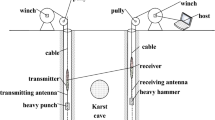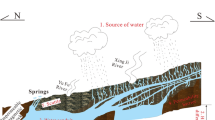Abstract
Electromagnetic wave CT, containing velocity CT and attenuation CT, is one of the effective geophysical prospecting methods to detect underground caves. The accuracy is low when applying the velocity CT and the attenuation CT separately into investigation in a karst area. This paper briefs the basic theory of electromagnetic wave CT imaging, and then mainly introduces the basic theory and applying methodology of cross-hole radar tomography for exploration in a karst area. Through numerical value simulation and practice verification, the advantage and disadvantage of the velocity CT and the attenuation CT of electromagnetic wave based on very high frequency have been studied, respectively. It has been found that the attenuation CT does better in confirming the location of karst caves, and the velocity CT is better in determining the shape of the karst caves although the whole distribution regular of the velocity CT is almost consistent with the attenuation CT.






Similar content being viewed by others
References
Anderson DL, Dziewonski AM (1984) Seismic tomography: Sci. Amer. 251(4):60–68
Born M, Wolf E, Bhatia AB (1964) Principles of optics. Cambridge University Press, Cambridge
Debski W, Young RP (1999) Enhanced velocity tomography: practical method of combining velocity and attenuation parameters. Geophys Res Lett 26(21):3253–3256
Dines KA, Lytle RJ (1979) Computerized geophysical tomography. In: Proceedings of Institute of Electrical and Electronics Engineers (IEEE), vol 67(7), pp 1065–1073
Hounsfield GN (1973) Method and apparatus for measuring X or gamma radiation absorption or transmission at plural angles and analyzing the data: U.S. Patent 3 778614
Huang JH, Song L, Cui GX (1999) Application of cross-hole radar tomography in studying characteristics of strata thickly buried. J China Univ Min Technol 28(6):256–260
Lane JW Jr, Joesten PK, Haeni FP, Vendl M, Yeskis D (1998) Use of borehole-radar methods to monitor the movement of a saline tracer in carbonate rock at Belvidere, Illinois. In: Proceedings of the symposium on the application of geophysics to engineering and environmental problems, March 22–26, Chicago, pp 323–332
Lane JW Jr, Wright DL, Haeni FP (1999) Borehole radar tomography using saline tracer injections to image fluid flow in fractured rock. In: Proceedings of the US Geological Survey Toxic Substances Hydrology Program, US Geological Survey Water-Resources Investigation Report 99-4018C, vol 3, pp 747–756
Niva B, Olsson O, Blumping P (1988) Radar crosshole tomography at the Grimsel Rock Laboratory with application to migration of saline tracer through fracture zones, Nationale Genossenschaft fur die lagerung radioaktiver Abfalle, NTB 88-31
Olsson O, Anderson P, Gustafson E (1991) Site characterization and validation-monitoring saline tracer transport by borehole radar measurements. Final report, Stripa Project, TR 91-18, Swedish Nuclear Fuel and Waste Management Company, Stockholm, Sweden
Olsson O, Anderson P, Carlsten S, Falk L, Niva B, Sandberg E (1992) Fracture characterization in crystalline rock by borehole radar. In: Pilon J (ed) Ground penetrating radar, Geological Survey of Canada, Paper 90-4, pp 139–150
Ramirez AL, Lytle RJ (1986) Investigation of fracture flow paths using alterant geophysical tomography. Int J Rock Mech Min Sci Geomech (Abstracts) 23(2):165–169
Sandberg EV, Olsson OL, Falk LR (1989) Combined interpretation of fracture zones in crystalline rock using single hole, crosshole, tomography and directional borehole radar data. In: The 3rd minerals and geotechnical logging society (MGLS) international symposium on borehole geophysics, Las Vegas, Nevada
Seje C, Sam J, Anders W (1995) Radar techniques for indicating internal erosion in embankment dams. J Appl Geophys 33(1):143–156
Singh RP, Singh YP (1991) RAYPT: a new technique for inversion of geotomographic data. Geophysics 56(8):1215–1227
The 2nd institute of investigation and design of Railway Bureau (2000) Series technologies for construction Nanning–Kunming railway line with complex geology and dangerous mountain area. Press of Chengdu Electronic Science and Technology University, pp 92–97
William D, Earle O (1991) Cross-borehole resistivity tomography. Geophysics 56(8):1228–1235
Wright DL, Grover TP, Ellefsen KJ, Lane JW Jr, Kase PG (1996) Radar tomograms at Mirror Lake, New Hampshire: 3-D visualization and a Brine Tracer Experiment. In: Proceedings of the Symposium on the Application of Geophysics to Engineering and Environmental Problems, April 28–May 2 1996, Keystone, pp 565–575
Acknowledgments
This paper is part of result of the project funded by Science and Technology of Western Traffic Construction Items under the grant of No.200231800018 and NSFC under grant of No. 40772188. The authors also give great thanks to two anonymous reviewers for their kind comments and suggestions, which greatly improve the quality of the manuscript.
Author information
Authors and Affiliations
Corresponding author
Rights and permissions
About this article
Cite this article
Tan, H., Huang, J. & Qi, S. Application of cross-hole radar tomograph in karst Area. Environ Earth Sci 66, 355–362 (2012). https://doi.org/10.1007/s12665-011-1244-0
Received:
Accepted:
Published:
Issue Date:
DOI: https://doi.org/10.1007/s12665-011-1244-0




